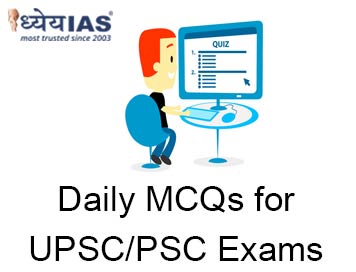Home > Daily-mcqs
Daily-mcqs 07 Feb 2025

Q1:
When was the MISHTI Initiative launched?
A: World Oceans Day (June 8, 2023)
B: World Environment Day (June 5, 2023)
C: Earth Day (April 22, 2023)
D: International Day for Biological Diversity (May 22, 2023)
Answer: B
Explanation:
The MISHTI Initiative was launched on World Environment Day (June 5, 2023).
Q2:
Consider the following economic measures: 1. Increasing interest rates to control inflation 2. Implementing price controls on essential goods 3. Providing subsidies to domestic agricultural producers 4. Reducing corporate taxes to encourage investment How many of the above measures can be classified as Supply-Side Economics policies?
A: Only 1
B: Only 2
C: Only 3
D: All four
Answer: B
Explanation:
Q3:
Consider the following statements regarding Mangroves: 1. Mangroves are found mainly in tropical and sub-tropical inter-tidal regions of the world. 2. Mangrove forests are one of the most productive and biodiverse wetlands on earth. 3. They exhibit very low capacity for saltwater tolerance. 4. Gujarat has the maximum mangrove cover in the country, followed by West Bengal and Andaman & Nicobar Islands. How many of the above statements is/are correct?
A: Only 1
B: Only 2
C: Only 3
D: All four
Answer: B
Explanation:
Q4:
With reference to United Nations Human Rights Council (UNHRC), consider the following statements: 1. Recently, United States has withdrawn from UN Human Rights Council (UNHRC). 2. It is a United Nations body whose mission is to promote and protect human rights around the world. 3. The members of the Council serve for a period of three years and they are not eligible for immediate re-election after serving two consecutive terms. How many of the above statements is/are correct?
A: Only 1
B: Only 2
C: All three
D: None
Answer: B
Explanation:
Q5:
Assertion (A): The Supreme Court’s directive to classify sacred groves as forests under the Wildlife Protection Act (WLPA), 1972, may undermine the traditional conservation practices of local communities. Reason (R): The Forest Rights Act (FRA), 2006, empowers local communities to manage community forest resources through gram sabhas, which conflicts with the government’s control over sacred groves. Select the correct answer from the options below:
A: Both Assertion and Reason are correct, and the Reason is the correct explanation for the Assertion.
B: Both Assertion and Reason are correct, but the Reason is not the correct explanation for the Assertion.
C: Assertion is correct, but the Reason is incorrect.
D: Assertion is incorrect, but the Reason is correct.
Answer: B
Explanation: